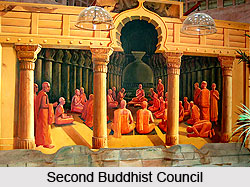 The Second Buddhist council took place in Vesali (also named as Vaishali, it is an ancient city that once served the capital of the Licchavis and the Vajjian Confederacy), approximately one hundred years after the Buddha`s Parinibbana (it is the final nirvana, normally understood to be within the reach only upon the death of the body of someone who has attained complete awakening (bodhi)), in order to settle a grievous dispute on Vinaya (a word in Pali as well as in Sanskrit, this is the regulatory framework for Buddhist monastic community, or sangha, based in the canonical texts called Vinaya Pitaka). The orthodox monks were able to persuade the monks whose behaviour was under scrutiny. Accounts of the dispute are preserved in the Vinaya texts of several of the early Buddhist schools.
The Second Buddhist council took place in Vesali (also named as Vaishali, it is an ancient city that once served the capital of the Licchavis and the Vajjian Confederacy), approximately one hundred years after the Buddha`s Parinibbana (it is the final nirvana, normally understood to be within the reach only upon the death of the body of someone who has attained complete awakening (bodhi)), in order to settle a grievous dispute on Vinaya (a word in Pali as well as in Sanskrit, this is the regulatory framework for Buddhist monastic community, or sangha, based in the canonical texts called Vinaya Pitaka). The orthodox monks were able to persuade the monks whose behaviour was under scrutiny. Accounts of the dispute are preserved in the Vinaya texts of several of the early Buddhist schools.
Some time after the Second Council, rifts occurred within the monastic Sangha, which led to the formation of several subgroups like Sthaviravada, Mahasanghika and Sarvastivada. The occurrence of these schools is sometimes related to the Second Council, but there is no validation for this suggestion - all the early canonical accounts state that the conflict was dissolved.
The dispute sprang up over the `Ten Points`. This is a reference to claims of some monks breaching ten rules, some of which were considered crucial.
The specific ten points were:
1. Stacking salt in a horn.
2. Eating after midday.
3. Eating once and then going again to a village for alms.
4. Holding the Uposatha Ceremony with monks inhabiting in the same locality.
5. Carrying out official acts when the assembly was unfinished.
6. Following a specific practice because it was done by one`s teacher.
7. Drinking sour milk after one have had his midday meal.
8. Consuming liquor before it had been fermented.
9. Using a carpet which was of improper size.
10. Making use of gold and silver.
The central issue was the use of `gold and silver`, which is an Indic idiom that comprises any sort of money. The monks of Vesali had taken to vagabonding for alms with the specific goal of gathering money, to which the visiting monk Yasa objected. Some of the other points are also of significance, such as point 6, which would allow monks to not follow the Vinaya on any point which their teacher did not abide by or practice.
This behaviour was taken to note, became an issue and caused a substantial disputation. The monastic Sangha is structured so that all actions and decisions must be unanimously agreed upon through perfect agreement. Since the monks charged of breaking these ten rules refused to be remonstrated or admit fault, the Sangha was unable to settle this dispute in any other way than by calling forth the Second Buddhist Council. The council took place in c. 4th century BCE.
Some of the Ten Points were against minor (Dukkata or sekhiya) rules. Before the Buddha`s Parinibbana he told Venerable Ananda that the community might (unanimously) dispense with the minor rules of the Vinaya, but in the First Buddhist Council there was dubiousness about which rules he was referring to and it was collectively decided to keep the Vinaya as it was during the Buddha`s lifetime. However, 100 years later some monks felt that certain rules could be loosened up.
The Second Buddhist Council made the unanimous decision not to relax any of the rules, and reprimanded the behaviour of the monks who were charged of profaning the ten points.









